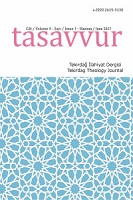Kur’ân’ın Secili Söz Dizgelerinin 7. Yüzyıl Arapların Lügavî Örf ve Âdetleriyle Diyalektik İlişkisi
The Dialectical Relationship of the Syntax of the Qur’ān with the Lexical Customs and Traditions of the 7th Century Arabs
Author(s): Emrah DindiSubject(s): Language studies, Islam studies, Syntax, Lexis, Historical Linguistics, 6th to 12th Centuries, Qur’anic studies
Published by: Tekirdağ Namık Kemal Üniversitesi İlahiyat Fakültesi
Keywords: Commentary; Qur’ān; Seciʿ; Seventh Century; Arabic Language Customs and Traditions;
Summary/Abstract: One of the most basic stylistic characteristics of the Qur’ān is the agree-ment between syllables, sounds, lines and rhymes repeated at the end of the verses and give the same harmony. The question/problem “Are these words that have pleasant melodic structures and superior arts something that the Arabs of the 7th century Hejaz Region did not know, were not familiar with and did not hear, or are they expressions that existed in oral and literary types in their daily vocabulary formed and embodied within the framework of well-known lexical customs and literary tastes?” is discussed in this article. For this purpose, the study examines the seciʿ and rhyming word structures in the verbal and literary discourses of the Jahiliya period Arabs. Then, based on the data in the ancient Islamic Literature, it examines the dialectical relationship of the melodic structures at the end of the verses of the Qur’ān with the characteristics of the seciʿ and rhyming literary products in the poems of the Arab poets of ignorance, and for the choice that the Arab society made it a custom and habit at that time to observe at the end of the words, and whether some rules of comparison of the language were abandoned or not. Of course, although the dialectical relationship between the seciʿ expression structures of the Qur’ān and the literary tastes of the Arabs of that period was addressed in the former literature with a weak and feeble voice between the lines, unfortunately, this has not been examined in modern studies yet. For this reason, we hope that the present study, which we think is original and authentic, will contribute to this field and as a result of the study, in which the literature review method was used, whether the harmonious, rhythmic, melodic sound and meter structures of the Qur’ān at the end of the verses are related to the literary tastes, lexical customs and traditions of the 7th century Arabs, or rather, these expressions were unknown to the Arabs of that day, will be uncovered along with the question whether it existed in a wonderful, transcendent and transcendent language and style that they were not familiar with, or in a local, regional, cultural anthropological nature that was compatible and agreeable with their tastes and expectations in that time.
Journal: Tasavvur Tekirdağ İlahiyat Dergisi
- Issue Year: 9/2023
- Issue No: 1
- Page Range: 545-578
- Page Count: 34
- Language: Turkish

